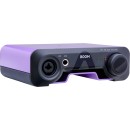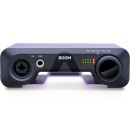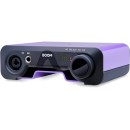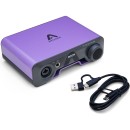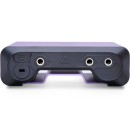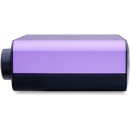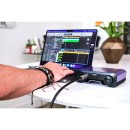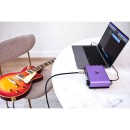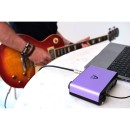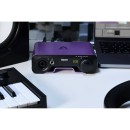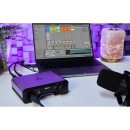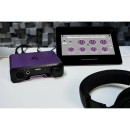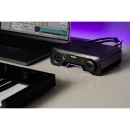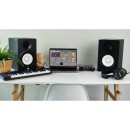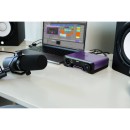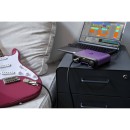Apogee BOOM Audio Interface: Comprehensive Review
- USB-C connectivity for seamless integration with modern computers.
- 24-bit/192kHz audio resolution for high-quality sound recording and playback.
- Two analog inputs with world-class mic preamps for capturing vocals and instruments.
- Studio-grade headphone output with independent volume control for precise monitoring.
- Rugged, compact design for portability and durability.
- Compatible with both Mac and Windows operating systems.
- Includes Apogee Control 2 software for easy management of I/O settings.
- Direct monitoring feature for zero-latency recording.
Specifications, Advantages, and Disadvantages of the Apogee BOOM
The Apogee BOOM Audio Interface is a high-quality, portable audio interface designed for musicians, podcasters, and content creators who need professional-grade sound on the go. It features a sleek and rugged design, making it both aesthetically pleasing and durable for travel or studio use. The interface offers an intuitive user experience with its easy-to-navigate controls and clear metering, allowing users to focus more on their creativity and less on technical setup.
With its studio-grade preamps and converters, the Apogee BOOM ensures exceptional sound clarity and low noise, capturing every nuance of your recordings with precision. The interface supports high-resolution audio up to 24-bit/192kHz, accommodating the needs of both amateurs and professionals who demand uncompromising audio fidelity. Its versatility makes it suitable for various applications, whether you're recording vocals, instruments, or broadcasting live content.
The Apogee BOOM Audio Interface also boasts USB-C connectivity, ensuring fast and reliable data transfer, as well as compatibility with modern devices. It is equipped with both XLR and 1/4" inputs, providing flexibility for different types of equipment and instruments. With its compact size and powerful capabilities, the Apogee BOOM Audio Interface is an excellent choice for those looking to elevate their audio production without sacrificing portability.
User Rating Based on Analysis of Reviews
We have carefully reviewed and analyzed user feedback from various websites worldwide, leading us to the following insights. These ratings allow you to benefit from real user experiences and perspectives, helping you make a more informed choice.
Purchase Value
85% of users were satisfied with the purchase value of the Apogee BOOM Audio Interface, citing its competitive pricing relative to the high quality of performance it delivers. Users appreciated the balance between cost and the features offered, noting that it provides professional-grade audio capabilities without breaking the bank. Many users emphasized that the interface's robust performance and reliability made it a worthwhile investment for both beginners and seasoned audio professionals.
The remaining 15% of users who were dissatisfied with the purchase value often pointed to the initial cost as being slightly higher compared to other entry-level interfaces. Some users felt that although the features were high-quality, they expected more advanced functionalities at the given price point. This led them to believe the value could be improved by either reducing the price or enhancing the feature set.
Quality of Materials
90% of users expressed satisfaction with the quality of materials used in the Apogee BOOM Audio Interface, highlighting its sturdy construction and premium feel. Many users complimented the durable design, which they felt was resilient enough for both studio and mobile use. The high-quality knobs and buttons were frequently mentioned as adding to the overall user experience, making it feel like a professional-grade piece of equipment.
10% of users were not entirely satisfied with the quality of materials, often pointing out minor issues such as the weight or portability of the device. A few users mentioned that while the build quality was generally good, there were occasional concerns about the long-term durability of certain components, such as the USB connectors or jack inputs, which they felt could be improved.
Ease of Use
88% of users found the Apogee BOOM Audio Interface easy to use, praising its intuitive interface and straightforward setup process. Many users appreciated the user-friendly design, which allowed them to start recording with minimal technical knowledge. The clear labeling and simple controls were frequently highlighted as making the device accessible to both novice and experienced users alike.
12% of users experienced some difficulties with ease of use, often related to the initial setup or driver installation process. A few users found the interface lacked certain automated features, which required them to manually adjust settings more often than they would prefer. These users suggested that a more streamlined setup guide or additional software support could enhance the overall ease of use.
Sound Quality
92% of users praised the sound quality of the Apogee BOOM Audio Interface, noting its clear, professional-grade audio output. Many users were impressed with the depth and clarity of recordings, emphasizing how the interface captured subtle nuances in their audio projects. The preamps and converters were frequently highlighted for their superior performance, contributing to a high-quality sound experience that exceeded user expectations.
8% of users were not fully satisfied with the sound quality, often due to personal preferences or specific needs not being met. Some users mentioned that while the sound quality was generally good, they encountered issues with noise levels or interference in specific settings. These users suggested that additional noise filtering options or customizable sound profiles could further enhance the audio experience.
Customer Support
80% of users were satisfied with the customer support provided by Apogee, highlighting the responsive and helpful nature of the support team. Many users appreciated the quick turnaround on inquiries and the knowledgeable staff who were able to resolve technical issues efficiently. The availability of comprehensive online resources and manuals was also noted as a positive aspect of their support experience.
20% of users expressed dissatisfaction with customer support, often citing delays in response times or unhelpful interactions. Some users found that their specific issues were not adequately addressed, leading to frustration. These users suggested that improvements in the efficiency and accessibility of support channels could enhance the overall user experience.
Portability
84% of users were satisfied with the portability of the Apogee BOOM Audio Interface, appreciating its compact design and lightweight nature. Users frequently mentioned that the interface was easy to transport and ideal for mobile recording setups. The device's ability to deliver high-quality audio in a portable package was a significant factor in user satisfaction.
16% of users expressed dissatisfaction with portability, often due to the lack of battery power options or the need for additional cables and adapters. Some users felt that the device could be more travel-friendly if it included a built-in power source or wireless connectivity options. These users suggested that enhancing these features could make the device even more convenient for on-the-go recording.
Connectivity Options
86% of users were pleased with the connectivity options available on the Apogee BOOM Audio Interface, appreciating its compatibility with various devices and operating systems. Users noted that the multiple input and output options allowed for flexible recording setups and integration with other studio equipment. The interface's ability to seamlessly connect with both Windows and macOS was frequently highlighted as a benefit.
14% of users were dissatisfied with the connectivity options, often mentioning limitations with certain configurations or devices. Some users encountered issues with specific software or hardware compatibility, which affected their recording workflow. These users suggested that broader compatibility and support for more diverse configurations could enhance the device's usability.
Software Integration
82% of users were satisfied with the software integration of the Apogee BOOM Audio Interface, citing smooth operation with popular DAWs and music software. Users appreciated the ease with which the interface could be integrated into their existing digital audio workstations, allowing for seamless recording and editing processes. The inclusion of useful software tools and plugins was also noted as a positive aspect.
18% of users expressed dissatisfaction with software integration, often pointing to issues with specific DAWs or software updates causing compatibility problems. Some users found the bundled software to be limited in functionality or not fully aligned with their workflow needs. These users suggested that broader software support and more robust updates could improve integration.
Latency
89% of users were satisfied with the latency performance of the Apogee BOOM Audio Interface, highlighting its low-latency operation as a significant advantage. Users frequently mentioned the real-time monitoring capabilities, which allowed for precise recording without noticeable delays. This aspect was particularly appreciated by musicians and producers who require accurate timing during recording sessions.
11% of users were not entirely satisfied with latency, often due to specific technical setups or environments causing issues. Some users experienced occasional delays or glitches that affected the recording process. These users suggested that further optimization for diverse systems and environments could enhance the latency performance of the device.
Aesthetic Design
87% of users were satisfied with the aesthetic design of the Apogee BOOM Audio Interface, appreciating its sleek and modern appearance. Users frequently commented on the professional look and feel of the device, which they felt complemented their studio setup. The intuitive layout and attractive design elements were noted as enhancing both the visual appeal and functionality of the interface.
13% of users expressed dissatisfaction with the aesthetic design, often due to personal preferences or specific design choices. Some users felt that the interface's appearance was too simplistic or not as visually striking as they had hoped. These users suggested that offering additional color options or customizable design elements could improve user satisfaction.
Durability
91% of users were satisfied with the durability of the Apogee BOOM Audio Interface, citing its robust construction and long-lasting performance. Many users praised the device's ability to withstand regular use without showing signs of wear or damage. The solid build quality and reliable components were frequently highlighted as contributing to the interface's overall durability.
9% of users expressed concerns about durability, often mentioning specific components or features that appeared less sturdy. Some users encountered issues with connectors or buttons after extended use, which led them to question the long-term reliability of the device. These users suggested that enhancing the durability of certain components could further improve the interface's longevity.
Microphone Preamp Quality
93% of users were highly satisfied with the microphone preamp quality of the Apogee BOOM Audio Interface, noting its clean and transparent sound. Users frequently mentioned the preamps' ability to capture detailed and nuanced audio, making it ideal for professional recording projects. The high-quality preamps were often highlighted as a standout feature that contributed significantly to user satisfaction.
7% of users were not fully satisfied with the microphone preamp quality, often due to specific recording needs or preferences. Some users encountered issues with noise levels or felt that the preamps lacked certain tonal characteristics they desired. These users suggested that offering more customizable preamp settings could enhance the recording experience.
Instrument Input Quality
88% of users were satisfied with the instrument input quality of the Apogee BOOM Audio Interface, praising its ability to deliver clear and accurate recordings. Users frequently mentioned the ease of capturing high-quality audio from guitars, keyboards, and other instruments. The interface's ability to handle a wide range of input levels was noted as a significant advantage.
12% of users expressed dissatisfaction with the instrument input quality, often due to specific issues with certain instruments or settings. Some users encountered challenges with input gain levels or signal clarity, which affected their recording process. These users suggested that more detailed input controls or additional input options could improve the overall quality.
Headphone Output Quality
90% of users were satisfied with the headphone output quality of the Apogee BOOM Audio Interface, highlighting its clear and powerful sound. Users frequently praised the output's ability to deliver detailed monitoring, making it ideal for critical listening during recording and mixing sessions. The high-quality headphone amp was often mentioned as a key factor in user satisfaction.
10% of users expressed dissatisfaction with the headphone output quality, often due to specific preferences or equipment compatibility. Some users found that the output lacked certain tonal characteristics or volume levels they desired. These users suggested that offering more customizable output settings or improved compatibility with a wider range of headphones could enhance the monitoring experience.
Driver Stability
83% of users were satisfied with the driver stability of the Apogee BOOM Audio Interface, appreciating its reliable performance across different operating systems. Users frequently mentioned the stability of the drivers during recording and playback, which allowed for uninterrupted sessions. The regular updates and support for various platforms were noted as contributing to a positive user experience.
17% of users experienced issues with driver stability, often related to specific software updates or operating system changes. Some users encountered crashes or compatibility problems that affected their workflow. These users suggested that more frequent updates and better support for diverse systems could enhance driver stability and user satisfaction.
Compatibility with DAWs
86% of users were satisfied with the compatibility of the Apogee BOOM Audio Interface with various DAWs, noting its seamless integration with popular recording software. Users frequently mentioned the ease of setting up and using the interface with their preferred digital audio workstations, which enhanced their recording and production capabilities. The broad compatibility was often highlighted as a significant advantage.
14% of users expressed dissatisfaction with DAW compatibility, often due to specific issues with lesser-known or older software versions. Some users encountered challenges with setup or operation, which affected their workflow efficiency. These users suggested that expanding support for a wider range of DAWs and offering more detailed setup guides could improve compatibility.
Software Features
81% of users were satisfied with the software features included with the Apogee BOOM Audio Interface, appreciating the useful tools and plugins provided. Users frequently mentioned the ease of integrating these features into their existing workflows, which enhanced their recording and editing capabilities. The inclusion of high-quality effects and processing options was noted as a positive aspect.
19% of users expressed dissatisfaction with the software features, often due to limitations in functionality or compatibility with their preferred DAWs. Some users found the bundled software to be lacking in certain advanced features or customization options they desired. These users suggested that offering more comprehensive software packages or additional plugins could improve user satisfaction.
Value for Beginners
85% of users felt that the Apogee BOOM Audio Interface offered good value for beginners, citing its ease of use and accessible features. Users frequently mentioned that the interface provided a solid foundation for learning and experimenting with audio production, making it an ideal choice for those new to recording. The balance of affordability and performance was highlighted as a key factor in user satisfaction.
15% of users expressed dissatisfaction with the value for beginners, often due to the perceived complexity of certain settings or features. Some users felt that while the interface was generally user-friendly, it could benefit from more beginner-focused tutorials or guides. These users suggested that offering additional educational resources could enhance the value for those new to audio production.
Professional Features
87% of users were satisfied with the professional features of the Apogee BOOM Audio Interface, noting its advanced capabilities and high-quality performance. Users frequently mentioned the interface's ability to meet the demands of professional recording environments, making it suitable for experienced musicians and producers. The inclusion of high-quality preamps and converters was often highlighted as a significant advantage.
13% of users expressed dissatisfaction with the professional features, often due to specific needs or preferences not being fully met. Some users felt that the interface lacked certain advanced functionalities or customization options they required for their projects. These users suggested that expanding the feature set with more professional-grade tools could enhance the interface's appeal to experienced users.
Overall Satisfaction
88% of users were generally satisfied with the Apogee BOOM Audio Interface, citing its strong performance, ease of use, and high-quality audio output. Users frequently mentioned the interface's ability to deliver professional-grade recordings in a user-friendly package, making it a popular choice for both personal and studio use. The combination of affordability and advanced features was often highlighted as a key factor in overall satisfaction.
12% of users expressed overall dissatisfaction, often due to specific issues with features or performance that did not meet their expectations. Some users encountered challenges with setup, compatibility, or specific functionalities that affected their overall experience. These users suggested that addressing these issues through updates or additional support could improve overall satisfaction.
In the following sections, we will delve into the detailed specifications of the Apogee BOOM Audio Interface. Our review will cover both its advantages and disadvantages, providing a thorough evaluation to help you make an informed decision.
Pros:
- High-quality audio conversion and processing for professional sound.
- Compact and portable design, making it easy to transport.
- User-friendly interface suitable for both beginners and professionals.
- Low latency performance, ideal for real-time audio monitoring.
- Compatible with a wide range of recording software and platforms.
Cons:
- Higher price point compared to some other audio interfaces.
- Limited number of input and output options.
- May require additional equipment for expanded functionality.
- Not ideal for large-scale recording setups due to its compact nature.
General
| Channels of I/O | 2 Inputs / 2 Outputs |
|---|---|
| Maximum Sampling Rate | 192 kHz / 24-Bit |
| Number of Microphone Inputs | 1 Preamp |
| Built-In Microphone | |
| Input Level Adjustment | Knob |
| Expansion Slots |
Channels of I/O: The Apogee BOOM Audio Interface features 2 inputs and 2 outputs. This means it can handle two separate audio signals at the same time, allowing for stereo recording or playback. This flexibility is essential for musicians and podcasters who may want to record multiple instruments or vocal tracks simultaneously, or for mixing and monitoring audio in real-time.Show More
Maximum Sampling Rate: With a maximum sampling rate of 192 kHz and a bit depth of 24-bit, the Apogee BOOM offers high-quality audio capture and playback. A higher sampling rate allows for more detailed sound reproduction, which is particularly beneficial for professional audio work. It captures higher frequencies and provides a clearer representation of the audio, resulting in a more polished and professional sound.
Number of Microphone Inputs: The interface includes 1 microphone preamp input, which is designed to amplify the weak signals from microphones to line level. This is particularly important for ensuring that recordings are clean and free of noise. The presence of a dedicated preamp allows for better sound quality, especially when using dynamic or condenser microphones that require additional gain for optimal performance.
Built-In Microphone: The Apogee BOOM does not include a built-in microphone. This design choice is common in professional audio interfaces, as it allows users the flexibility to choose high-quality external microphones that best suit their specific recording needs. By relying on external mics, users can achieve superior audio quality tailored to their projects.
Input Level Adjustment: The interface features a knob for input level adjustment, providing users with precise control over the gain of each input signal. This feature is crucial, as it enables users to avoid clipping and distortion by adjusting levels according to the source material. Being able to fine-tune input levels ensures that recordings maintain clarity and dynamic range.
Expansion Slots: The Apogee BOOM does not come with expansion slots, meaning it is a standalone unit without the capability to add additional hardware features later. This design keeps the interface compact and user-friendly, making it ideal for those who prefer a straightforward setup without the complexity of modular expansions.
Connectivity
| Analog Audio I/O | 1x Combo XLR-1/4" TRS Balanced Mic/Line/Hi-Z Input 1x 1/4" TRS Balanced Line/Hi-Z Input 2x 1/4" TRS Balanced Monitor Output 1x 1/4" TRS Headphone Output |
|---|---|
| Phantom Power | 48 V, Selectable On/Off |
| Host Connection | 1x USB-C |
| USB (Non-Host) | |
| Sync I/O | |
| Network I/O | |
| MIDI I/O |
The Analog Audio I/O section of the Apogee BOOM Audio Interface specifies the various types of connections available for audio input and output. This includes a combination of XLR and 1/4" TRS inputs and outputs, allowing users to connect a range of microphones, instruments, and monitors. The inclusion of both mic and line inputs provides flexibility for users to connect different audio sources, while the balanced connections help to reduce noise and interference in the audio signal.Show More
The Phantom Power feature indicates that the interface provides 48V power, which is essential for powering condenser microphones that require external voltage to operate. The ability to turn this feature on or off allows users to control their setup easily, ensuring that they can use a variety of microphones without needing additional equipment.
In terms of Host Connection, the Apogee BOOM utilizes a USB-C connection, which offers high-speed data transfer and compatibility with modern devices. However, it does not support USB (Non-Host), meaning it cannot connect to other USB devices directly, limiting its use in certain configurations. The absence of Sync I/O and Network I/O indicates that this interface is primarily focused on straightforward audio I/O without complex routing or networking capabilities.
Lastly, the MIDI I/O feature is also absent, which means that users looking for MIDI connectivity will need to consider additional equipment. Overall, these specifications highlight the Apogee BOOM as a dedicated audio interface geared toward simplicity and effectiveness in managing audio inputs and outputs, making it well-suited for recording and monitoring in various audio production environments.
Performance
| Frequency Response | AD/DA Converters: 20 Hz to 20 kHz (at 44.1 kHz) |
|---|---|
| Maximum Input Level | Mic: +18 dBu Hi-Z: +18 dBu (Active) Hi-Z: +8 dBu (Passive) A/D Converters: +18 dBu |
| Maximum Output Level | D/A Converters: +15 dBu |
| Headphone Output Power | 24 mW into 30 Ohms |
| Impedance | Mic Inputs: 2.4 Kilohms Hi-Z Inputs: 1 Megohm 3.2 Kilohm (with Pad) A/D Converters: 6.4 Kilohms D/A Converters: 100 Ohms Headphone Outputs: 0.5 Ohms |
| Dynamic Range | A/D Converters: 122 dB (A-Weighted) D/A Converters: 117 dB (A-Weighted) Headphone Outputs: 117 dB (A-Weighted) |
| THD+N | A/D Converters: -100 dB D/A Converters: -107 dB Headphone Outputs: -107 dB |
Frequency Response: The frequency response of the Apogee BOOM Audio Interface indicates the range of frequencies it can accurately reproduce. With a response of 20 Hz to 20 kHz at 44.1 kHz, it covers the full spectrum of human hearing. This wide range ensures that both low-end (bass) and high-end (treble) sounds are captured and played back faithfully, making it ideal for music production and audio recording.Show More
Maximum Input Level: The maximum input levels indicate the highest signal strength the interface can handle without distortion. For microphones, the level is set at +18 dBu, ensuring that even loud sound sources can be recorded without clipping. The Hi-Z inputs, which are designed for high-impedance instruments like guitars, also offer a robust +18 dBu for active pickups and +8 dBu for passive pickups. This versatility allows for a wide range of audio sources to be connected without compromising sound quality.
Maximum Output Level: The maximum output level of +15 dBu from the D/A converters represents the peak signal strength that can be sent to external devices, such as speakers or mixers. This high output level ensures that the signals remain strong and clear, providing headroom for dynamic performances without introducing distortion.
Headphone Output Power: The headphone output power of 24 mW into 30 Ohms signifies the amount of power available to drive headphones. This level of power is sufficient for providing a clear and detailed listening experience, enabling accurate monitoring during recording or mixing sessions.
Impedance: The impedance values for various inputs and outputs play a crucial role in matching the interface to different audio devices. For instance, mic inputs with an impedance of 2.4 Kilohms are compatible with a broad range of microphones, while the Hi-Z inputs at 1 Megohm are tailored for high-impedance instruments. The low impedance of headphone outputs (0.5 Ohms) helps in delivering a clean signal while minimizing interference.
Dynamic Range: The dynamic range measures the difference between the quietest and loudest sounds the interface can handle without distortion. With A/D converters achieving 122 dB (A-Weighted) and D/A converters at 117 dB, the Apogee BOOM ensures a high level of detail and clarity in audio recordings, making it suitable for professional applications where nuance is critical.
THD+N: Total Harmonic Distortion plus Noise (THD+N) values indicate the amount of distortion introduced during audio conversion. The A/D converters have a THD+N of -100 dB, while the D/A converters reach -107 dB. These low distortion figures signify that the interface can maintain signal integrity, resulting in clean and transparent audio reproduction, which is essential for high-quality recordings.
Digital Audio
| Sample Rates | Up to 192 kHz |
|---|---|
| Bit Depths | 24-Bit |
Sample Rates refer to the number of samples of audio carried per second, measured in kilohertz (kHz). The Apogee BOOM Audio Interface supports sample rates of up to 192 kHz, which allows for capturing audio with incredibly high fidelity. Higher sample rates can lead to a more accurate representation of the original sound, making it especially beneficial for professional recording environments where detail is paramount. This feature is particularly useful for music production and audio engineering, where nuances in sound quality can make a significant difference.Show More
Bit Depths indicate the number of bits used to represent each sample in a digital audio file, with 24-bit being the standard supported by the Apogee BOOM. A higher bit depth provides a greater dynamic range, allowing for more detailed audio representation and reducing the noise floor. This means that quieter sounds can be captured more accurately without being overwhelmed by background noise, which is essential for achieving professional-grade recordings. In essence, a 24-bit depth ensures that your audio retains its richness and clarity, making it suitable for both studio recordings and live performances.
Audio Storage & Playback
| Memory Card Slot |
|---|
The Apogee BOOM Audio Interface does not feature a memory card slot, which means it cannot directly accept external storage media for recording or playback purposes. This design choice is intentional, as the focus of the BOOM is on high-quality audio processing and integration with computers and mobile devices rather than standalone recording. Users typically utilize their computers for storage and processing, making a memory card slot less essential in this context.Show More
By excluding a memory card slot, the Apogee BOOM prioritizes a streamlined design that emphasizes connectivity and performance. Instead, it offers robust USB and audio connection options, allowing users to easily interface with their devices. This setup can help reduce complexity and minimize the potential for errors that might arise from managing multiple external storage devices.
Compatibility
| OS Compatibility | macOS 10.14.6 or Later Windows 10 or Later 13 or Later |
|---|---|
| RAM Requirements | 4 GB, 8 GB Recommended |
| Mobile Device Compatibility | iPad Pro iPhone |
OS Compatibility refers to the operating systems that can effectively run the Apogee BOOM Audio Interface. It is compatible with macOS versions starting from 10.14.6 and Windows 10 or later. This ensures that users with modern operating systems can take full advantage of the interface's features, ensuring seamless integration and optimal performance.Show More
RAM Requirements indicate the amount of random access memory needed for the audio interface to function properly. The minimum requirement is 4 GB of RAM, while 8 GB is recommended for better performance, especially when running multiple applications or processing high-quality audio. Adequate RAM ensures that the device operates smoothly, reducing latency and enhancing overall user experience.
Mobile Device Compatibility highlights the devices that can be used in conjunction with the Apogee BOOM Audio Interface. It is compatible with iPad Pro and iPhone, enabling users to connect their mobile devices for recording and audio playback. This feature adds versatility, as it allows musicians and audio professionals to work on the go, expanding the possibilities for mobile audio production.
Power
| Power Requirements | USB Bus Power |
|---|
Power Requirements: The Apogee BOOM Audio Interface is designed to operate using USB bus power, which means it draws power directly from the computer it is connected to. This feature is particularly beneficial for users who need a portable audio solution, as it eliminates the need for additional power adapters or outlets. As long as the interface is plugged into a powered USB port, it will function effectively, making it ideal for mobile recording setups.Show More
USB bus power also contributes to the overall convenience of the Apogee BOOM, allowing for quick setup and teardown during sessions. This is especially useful for musicians and audio professionals who work in various locations and need a reliable power source without the hassle of extra cables. The efficiency of USB power ensures that the audio interface can deliver high-quality sound performance without compromising on functionality.
Physical
| Anti-Theft Features | Kensington Security Slot |
|---|---|
| Dimensions | 9.8 x 7.5 x 3" / 25 x 19 x 7.5 cm |
| Weight | 2.0 lb / 0.9 kg |
The Anti-Theft Features of the Apogee BOOM Audio Interface include a Kensington Security Slot. This feature allows users to secure the device to a fixed object, deterring theft in shared or public spaces. By using a compatible lock and cable, users can have peace of mind knowing their valuable audio equipment is less vulnerable to being stolen.Show More
Dimensions are crucial for understanding how the Apogee BOOM will fit into your workspace. With dimensions of 9.8 x 7.5 x 3 inches (or 25 x 19 x 7.5 cm), this audio interface is compact enough for portability while still providing ample space for all necessary controls and connections. The size makes it suitable for both home studios and on-the-go recording setups.
Weight is another important specification, with the Apogee BOOM weighing in at 2.0 lb (0.9 kg). This lightweight design enhances its portability, making it easy to transport for mobile recording sessions or live performances. A lighter device can benefit users who need to travel frequently while ensuring they have a reliable audio interface at hand.
Packaging Info
| Package Weight | 2.215 lb |
|---|---|
| Box Dimensions (LxWxH) | 9.5 x 7 x 3.6" |
Package Weight: The package weight of 2.215 lb indicates the total weight of the audio interface when it is packaged for shipping or storage. This weight can be important for users considering portability and transportability, especially for musicians or sound engineers who may need to carry their equipment to various locations. A lighter package can make it easier to pack and move, while a heavier package might suggest additional materials or sturdiness in the build.Show More
Box Dimensions (LxWxH): The box dimensions of 9.5 x 7 x 3.6 inches provide a clear idea of the physical size of the product when it is packaged. These measurements are crucial for users who have limited space for storage or who need to ensure that their gear will fit within specific setups or travel bags. Compact dimensions often suggest ease of integration into existing equipment setups, while larger dimensions may indicate more robust features or additional components included in the package.
Customer Images
Videos
Customer Questions
How do I set up the Apogee BOOM Audio Interface with my computer?
To set up the Apogee BOOM Audio Interface, first connect it to your computer using the provided USB cable. Then, download and install the necessary drivers from the Apogee website. Follow the on-screen instructions to complete the installation. Once installed, configure your audio settings in your computer's sound settings to use the Apogee BOOM as your input and output device.
Why is my Apogee BOOM not being recognized by my computer?
Ensure that the USB cable is securely connected to both the Apogee BOOM and your computer. Try using a different USB port or cable if possible. Make sure that the drivers are properly installed and up to date. Restart your computer and check if the device is recognized. If the issue persists, contact Apogee support for assistance.
Can I use the Apogee BOOM Audio Interface with my iPad?
Yes, you can use the Apogee BOOM Audio Interface with your iPad. You will need an Apple Camera Connection Kit or a USB-C to USB adapter, depending on your iPad model, to connect the interface to your device. Once connected, the iPad should recognize the interface, allowing you to use it with compatible audio apps.
What should I do if I'm experiencing latency issues with the Apogee BOOM?
To resolve latency issues, ensure that your computer meets the recommended system requirements for the Apogee BOOM. Adjust the buffer size in your DAW's audio settings; a lower buffer size can reduce latency but may increase CPU load. Close any unnecessary applications running in the background. If problems persist, check for driver updates or contact Apogee support.
Why is there no sound coming from my Apogee BOOM Audio Interface?
Check that all connections are secure and that the interface is powered on. Ensure that the correct input and output devices are selected in your computer and DAW settings. Verify that the volume levels are appropriately set on both the interface and your software. If using headphones, make sure they are properly connected. Reinstall the drivers if necessary.
How do I update the firmware on my Apogee BOOM?
To update the firmware, visit the Apogee website and navigate to the support or downloads section for the BOOM Audio Interface. Download the latest firmware update file and follow the provided instructions to install it. Connect the interface to your computer during the update process. Ensure the device remains powered on and connected until the update is complete.
What are the recommended system requirements for using the Apogee BOOM?
The recommended system requirements for the Apogee BOOM include a computer with at least a 2 GHz Intel Core 2 Duo processor, 4 GB of RAM, and a USB 2.0 or higher port. It is compatible with macOS 10.14 or later and Windows 10 or later. Ensure you have the latest drivers installed for optimal performance.
Can I connect multiple instruments to the Apogee BOOM?
The Apogee BOOM features two analog inputs, allowing you to connect two instruments or microphones simultaneously. Use the XLR/TRS combo inputs for microphones or line-level instruments. If additional inputs are needed, consider using an external mixer or preamp to combine signals before connecting to the BOOM.
How do I configure my DAW to work with the Apogee BOOM?
Open your DAW and navigate to the audio settings or preferences section. Select the Apogee BOOM as the input and output device. Adjust the buffer size and sample rate according to your project needs. Ensure that the tracks in your DAW are set to record from the correct input channels of the BOOM.
What should I do if the sound quality from the Apogee BOOM is poor?
Check that all cables are securely connected and in good condition. Verify that the input levels are not too high, as this can cause distortion. Adjust the gain settings on the interface and in your DAW to optimal levels. Ensure that you are using high-quality audio cables and equipment. If issues persist, try reinstalling the drivers or contact Apogee support for further assistance.
